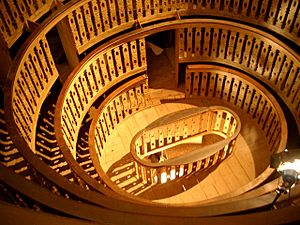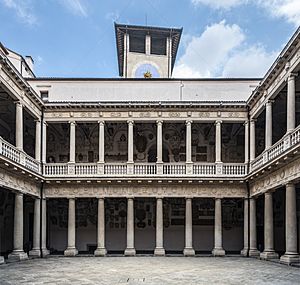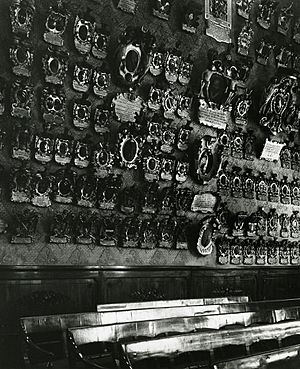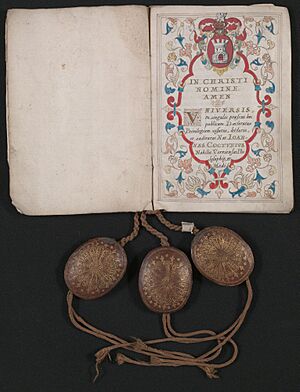University of Padua facts for kids
|
Università degli Studi di Padova
|
|
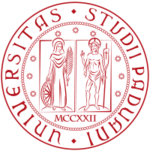 |
|
| Latin: Universitas Studii Paduani | |
| Motto | Latin: Universa Universis Patavina Libertas |
|---|---|
|
Motto in English
|
Liberty of Padua, universally and for all |
| Type | Public research university |
| Established | September 1222 |
| Accreditation | MIUR |
| Budget | €831 million (2023) |
| Rector | Daniela Mapelli |
|
Academic staff
|
4,580 (2021) |
|
Administrative staff
|
2,432 (2021) |
| Students | 72,280 (2021) |
| Undergraduates | 38,969 (2021) |
| Postgraduates | 31,827 (2021) |
| 1,484 (2021) | |
| Location |
,
Italy
|
| Campus | Urban (University town) |
| Sports teams | CUS Padova |
| Colors | Padua Red |
| Affiliations | Coimbra Group, TIME network |
The University of Padua (also known as UNIPD) is a famous public university in Padua, Italy. It started in 1222 when students and teachers from the University of Bologna moved there. This makes it the second-oldest university in Italy. It is also the fifth-oldest university in the world that is still open today.
The University of Padua was very important in early modern Europe. It was known for its strong focus on science and logic. It played a big part in the Italian Renaissance, teaching many famous thinkers like Nicolaus Copernicus.
As of 2021, the university has 32 departments and eight schools. It is part of the Coimbra Group, which is a network of old and respected research universities. In 2021, about 72,000 students attended the university. This included students studying for their first degree, master's degrees, and PhDs.
Contents
History
How the University Started
The University of Padua began in 1222. A large group of students and professors left the University of Bologna. They were looking for more freedom to teach and learn, which is called 'academic freedom'. Before 1222, there were already schools in Padua that taught law and medicine.
The group from Bologna first went to the University of Vicenza. Later, they moved permanently to Padua. At first, the university taught law and theology. Soon, more subjects were added. By 1399, the university split into two main parts. One part, the Universitas Iuristarum, taught civil law and church law. The other part, the Universitas Artistarum, taught subjects like astronomy, philosophy, medicine, and rhetoric. There was also a separate school for theology, started in 1373.
Student Life and Growth
Students at the university were grouped into "nations." These groups were based on where the students came from. There were two main types of nations:
- the cismontanes for students from Italy
- the ultramontanes for students from beyond the Alps (other parts of Europe)
From the 1400s to the 1700s, the university was famous for its research. It was especially known for medicine, astronomy, philosophy, and law. At that time, it was the most famous medical school in the world. The university adopted a Latin motto: Universa universis patavina libertas. This means "Paduan Freedom is Universal for Everyone."
The university had some difficult times. There was no teaching between 1237–1261, 1509–1517, and 1848–1850.
Important Discoveries and Places
The Botanical Garden of Padova was started by the university in 1545. It is one of the oldest gardens of its kind in the world. Some people say it's the oldest academic garden, but another one was created in Pisa in 1544. Besides the garden, the university also has nine museums. One of these is a History of physics museum.
The university started teaching medicine around 1250. It became very good at understanding and treating diseases. It was known for doing autopsies to study how the human body works.
Since 1595, Padua's famous anatomical theatre has attracted artists and scientists. They came to study the human body during public dissections. It is the oldest permanent anatomical theatre still standing in Europe. A famous anatomist named Andreas Vesalius taught here. In 1543, he published his discoveries about the human body in a book. This book made many other European cities want to build their own anatomical theatres.
On June 25, 1678, Elena Lucrezia Cornaro Piscopia made history. She was a noblewoman and mathematician from Venice. She became the first woman ever to earn a Doctor of Philosophy degree.
Modern Times
In 1873, the university became part of the Kingdom of Italy. Since then, it has been one of the most respected universities in the country. It has made many important contributions to science and research. Famous mathematicians like Gregorio Ricci Curbastro and Galileo Galilei taught there.
In the late 1800s and early 1900s, the university grew. New science buildings were built, creating real campuses. A new building for the Arts and Philosophy faculty was built. The Astro-Physics Observatory was built in the mountains. The old main building, Palazzo del Bo, was fully restored.
The university faced challenges during the Fascist period and World War II. However, it kept teaching. In the second half of the 1900s, the university grew a lot. It worked closely with other top universities around the world, especially in science and technology.
In recent years, the university has expanded to other towns in the Veneto region. For example, an engineering institute opened in Vicenza in 1990. New centers for Agricultural Science and Veterinary Medicine opened in Legnaro in 1995. Other locations include Rovigo, Treviso, and Asiago.
In 1995, the University of Padua gained more independence. Today, it plays a big role in research around the world. It continues to work with other major research universities.
Organization and administration
Money and Budget
The University of Padua planned to spend €831 million in 2023. A large part of this money, €545 million, came from the Italian government, the European Union, and local governments. The rest, €232 million, was money the university earned itself. This included €106 million from tuition fees and €125 million from research projects.
The amount students pay for tuition depends on a few things. It depends on their major, their family's financial situation, and how long they take to finish their degree. Students from certain developing countries pay much less. There are also scholarships and ways to pay less based on good grades or other reasons. Most students who finish on time and are not from low-income families paid around €2,700 per year for the 2023/24 school year.
Rankings
| University rankings | |
|---|---|
| University of Padua | |
| Global – Overall | |
| ARWU World | 201–300 (2024) |
| CWTS World | 100 (2024) |
| QS World | =233 (2026) |
| THE World | 201–250 (2024) |
| USNWR Global | 130 (2024) |
The University of Padua is consistently ranked among the best universities in Italy.
In 2023, U.S. News & World Report ranked the University of Padua as the 1st best university in Italy. It was ranked 43rd in Europe and 115th in the world. The ARWU placed the university in the top 4 in Italy for 2023. It was tied for 2nd place with the University of Milan and the University of Pisa. Globally, ARWU ranked the university between 151st and 200th for 2023.
The 2024 Times Higher Education World University Rankings listed the university as 4th in Italy. It was ranked between 201st and 250th worldwide. QS World University Rankings ranked the university 4th in Italy in 2024. It was considered the best in Italy for studying geology, geophysics, earth and sea sciences, biological sciences, psychology, anatomy, and physiology. QS also placed the University of Padua at 219th in the world for 2024. For Medicine, the University of Padua was ranked 125th globally by QS.
The NTU Ranking, which looks at how much scientific research a university produces, placed the University of Padua as 82nd worldwide for 2022.
The CWTS Leiden Ranking, which uses special research data, ranked the University of Padua 2nd in Italy and 104th worldwide.
Notable people
Alumni
Many famous people have studied at the University of Padua:
- In natural sciences
- Nicolaus Copernicus (1473–1543) – A Polish astronomer who showed that the Sun is at the center of our Solar System.
- Vesalius (1514–1564) – Known as the founder of modern human anatomy.
- William Harvey (1578–1657) – An anatomist who described how the heart and blood circulatory system work.
- Thomas Browne (1605–1682) – A famous English writer and physician.
- Elena Cornaro Piscopia (1646–1684) – The first woman to receive a PhD degree.
- Federico Faggin (1941–) – Designed the first commercial microprocessor, a key part of computers.
- In politics and government
- Sir Francis Walsingham (ca 1532–1590) – A spymaster for Queen Elizabeth I of England.
- Jan Zamoyski (1542–1605) – A Polish nobleman and statesman.
- Ioannis Kapodistrias (1776–1831) – The first Governor of Greece.
- Luigi Luzzatti (1841–1927) – The 20th Prime Minister of Italy.
- In arts, theology and literature
- Saint Albertus Magnus (d.1280) – A famous philosopher and theologian.
- Pietro Bembo (1470–1547) – A well-known poet and cardinal.
- Francysk Skaryna (1470–1551/1552) – Printed the first book in an Eastern Slavic language.
- Torquato Tasso (1544–1595) – A famous Italian poet.
- Giacomo Casanova (1725–1798) – A famous traveler and author.
- Ugo Foscolo (1778–1827) – An important Italian writer and poet.
Notable faculty
- Ermolao Barbaro (1454–1493) – A professor of philosophy.
- Galileo Galilei (1564–1642) – A famous scientist who taught mathematics here.
- Elena Cornaro Piscopia (1646–1684) – Taught mathematics and was the first woman to get a PhD.
- Giovanni Battista Morgagni (1681–1771) – Taught theoretical medicine and anatomy.
- Tullio Levi-Civita (1873–1941) – Famous for his work in mathematics.
Departments
The University of Padua has many departments where students can study different subjects:
- Department of Agronomy, Food, Natural Resources, Animals and the Environment
- Department of Biology
- Department of Animal Medicine, Production and Health
- Department of Biomedical Sciences
- Department of Cardiac, Thoracic and Vascular Sciences
- Department of Chemical Sciences
- Department of Civil, Environmental and Architectural Engineering
- Department of Communication Sciences
- Department of Comparative Biomedicine and Food Science
- Department of Cultural Heritage: Archaeology and History of Art, Cinema and Music
- Department of Developmental Psychology and Socialisation
- Department of Economics and Management
- Department of General Psychology
- Department of Geosciences
- Department of Historical and Geographic Sciences and the Ancient World
- Department of Industrial Engineering
- Department of Information Engineering
- Department of Land, Environment, Agriculture and Forestry
- Department of Linguistic and Literary Studies
- Department of Management and Engineering
- Department of Mathematics
- Department of Medicine
- Department of Molecular Medicine
- Department of Neurosciences
- Department of Pharmaceutical and Pharmacological Sciences
- Department of Philosophy, Sociology, Education and Applied Psychology
- Department of Physics and Astronomy
- Department of Political and Juridical Sciences and International Studies
- Department of Private Law and Critique of Law
- Department of Public, International and Community Law
- Department of Statistical Sciences
- Department of Surgery, Oncology and Gastroenterology
- Department of Women's and Children's Health
Schools
The departments are grouped into a few larger Schools:
- Agricultural science and Veterinary medicine
- Economics and Political sciences
- Engineering
- Human and social sciences and cultural heritage
- Law
- Medicine and surgery
- Psychology
- Sciences
See also
 In Spanish: Universidad de Padua para niños
In Spanish: Universidad de Padua para niños
- List of oldest universities in continuous operation
- List of Italian universities
- List of medieval universities
- List of split up universities
- ICoN Interuniversity Consortium for Italian Studies
- Padua
- Coimbra Group
- Top Industrial Managers for Europe


